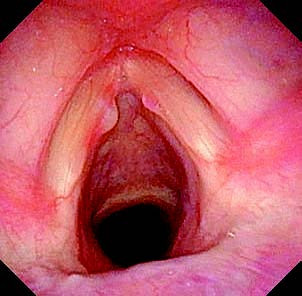Vocal cord polyps refer to translucent white or pink smooth-surfaced masses commonly occurring on the free edge of one or both vocal cords, particularly at the anterior and middle thirds. They are a frequent cause of hoarseness.
Etiology
Improper or excessive vocal use is a common cause of vocal cord polyps, which can also arise after a single instance of intense vocal strain. As a result, this condition is commonly seen in individuals with professional vocal demands or those who overuse their voice. It can also occur secondary to upper respiratory tract infections.
Pathology
The primary pathological change involves localized edema in Reinke's space of the vocal cord, along with vascular dilation or hemorrhage. The surface remains covered by normal squamous epithelium. Elliptical white or pink masses form, and in cases with a long disease duration, there may be prominent fibrous tissue proliferation or hyaline degeneration within the polyp.
Symptoms
The primary symptom is persistent hoarseness, and the severity correlates with the size and location of the polyp. Larger polyps tend to cause more significant hoarseness, while smaller ones cause milder symptoms. Polyps located on the free edge of the vocal cord have a greater impact on voice quality, whereas polyps on the superior surface of the vocal cord have less impact. Large broad-based polyps may result in aphonia. If the polyp is particularly large, it may obstruct the glottis, leading to inspiratory stridor and breathing difficulty.
Examination
Laryngoscopy reveals translucent, white, or pink masses on the anterior and middle thirds of the free edge of one or both vocal cords. These masses typically have a smooth surface and can be pedunculated or broad-based. Pedunculated polyps may move up and down during breathing. In rare cases, diffuse polypoid changes involving the entire vocal cord may be observed.

Figure 1 Vocal cord polyps
Treatment
Some vocal cord polyps may resolve spontaneously with strict voice rest and adequate recovery. If conservative treatment proves ineffective, surgical removal of the polyps can be performed. Common methods include excision under local anesthesia with a fiberoptic (or electronic) nasopharyngoscope or removal under general anesthesia using a microscopic suspension laryngoscope.